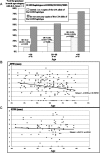Radiographic severity of knee osteoarthritis is conditional on interleukin 1 receptor antagonist gene variations
- PMID: 19934104
- PMCID: PMC2925146
- DOI: 10.1136/ard.2009.113043
Radiographic severity of knee osteoarthritis is conditional on interleukin 1 receptor antagonist gene variations
Abstract
Background: A lack of biomarkers that identify patients at risk for severe osteoarthritis (OA) complicates development of disease-modifying OA drugs.
Objective: To determine whether inflammatory genetic markers could stratify patients with knee OA into high and low risk for destructive disease.
Methods: Genotype associations with knee OA severity were assessed in two Caucasian populations. Fifteen single nucleotide polymorphisms (SNPs) in six inflammatory genes were evaluated for association with radiographic severity and with synovial fluid mediators in a subset of the patients.
Results: Interleukin 1 receptor antagonist (IL1RN) SNPs (rs419598, rs315952 and rs9005) predicted Kellgren-Lawrence scores independently in each population. One IL1RN haplotype was associated with lower odds of radiographic severity (OR=0.15; 95% CI 0.065 to 0.349; p<0.0001), greater joint space width and lower synovial fluid cytokine levels. Carriage of the IL1RN haplotype influenced the age relationship with severity.
Conclusion: IL1RN polymorphisms reproducibly contribute to disease severity in knee OA and may be useful biomarkers for patient selection in disease-modifying OA drug trials.
Conflict of interest statement
Figures

Similar articles
-
IL-1 receptor antagonist gene as a predictive biomarker of progression of knee osteoarthritis in a population cohort.Osteoarthritis Cartilage. 2013 Jul;21(7):930-8. doi: 10.1016/j.joca.2013.04.003. Epub 2013 Apr 18. Osteoarthritis Cartilage. 2013. PMID: 23602982 Free PMC article.
-
Interleukin 1 receptor antagonist (IL1RN) gene variants predict radiographic severity of knee osteoarthritis and risk of incident disease.Ann Rheum Dis. 2020 Mar;79(3):400-407. doi: 10.1136/annrheumdis-2019-216055. Epub 2019 Dec 18. Ann Rheum Dis. 2020. PMID: 31852669 Free PMC article.
-
Large-scale meta-analysis of interleukin-1 beta and interleukin-1 receptor antagonist polymorphisms on risk of radiographic hip and knee osteoarthritis and severity of knee osteoarthritis.Osteoarthritis Cartilage. 2011 Mar;19(3):265-71. doi: 10.1016/j.joca.2010.12.003. Epub 2010 Dec 10. Osteoarthritis Cartilage. 2011. PMID: 21146623 Review.
-
IL1B -511(G>A) and IL1RN (VNTR) allelic polymorphisms and susceptibility to knee osteoarthritis in Croatian population.Rheumatol Int. 2012 Jul;32(7):2135-41. doi: 10.1007/s00296-011-1946-3. Epub 2011 Apr 27. Rheumatol Int. 2012. PMID: 21523343
-
Vascular Adhesion Protein-1 (VAP-1) as Predictor of Radiographic Severity in Symptomatic Knee Osteoarthritis in the New York University Cohort.Int J Mol Sci. 2019 May 29;20(11):2642. doi: 10.3390/ijms20112642. Int J Mol Sci. 2019. PMID: 31146362 Free PMC article.
Cited by
-
IL-1 receptor antagonist gene as a predictive biomarker of progression of knee osteoarthritis in a population cohort.Osteoarthritis Cartilage. 2013 Jul;21(7):930-8. doi: 10.1016/j.joca.2013.04.003. Epub 2013 Apr 18. Osteoarthritis Cartilage. 2013. PMID: 23602982 Free PMC article.
-
Plasma cytokine levels and the presence of colorectal cancer.PLoS One. 2019 Mar 18;14(3):e0213602. doi: 10.1371/journal.pone.0213602. eCollection 2019. PLoS One. 2019. PMID: 30883594 Free PMC article. Clinical Trial.
-
Interleukin 1 receptor antagonist (IL1RN) gene variants predict radiographic severity of knee osteoarthritis and risk of incident disease.Ann Rheum Dis. 2020 Mar;79(3):400-407. doi: 10.1136/annrheumdis-2019-216055. Epub 2019 Dec 18. Ann Rheum Dis. 2020. PMID: 31852669 Free PMC article.
-
Serum C-reactive protein metabolite (CRPM) is associated with incidence of contralateral knee osteoarthritis.Sci Rep. 2021 Mar 22;11(1):6583. doi: 10.1038/s41598-021-86064-x. Sci Rep. 2021. PMID: 33753821 Free PMC article.
-
Genomics of pain in osteoarthritis.Osteoarthritis Cartilage. 2013 Sep;21(9):1374-82. doi: 10.1016/j.joca.2013.06.010. Osteoarthritis Cartilage. 2013. PMID: 23973152 Free PMC article. Review.
References
-
- Zhai G, Hart DJ, Kato BS, et al. Genetic influence on the progression of radiographic knee osteoarthritis: a longitudinal twin study. Osteoarthr Cartil 2007;15:222–5 - PubMed
-
- Attur MG, Dave M, Cipolletta C, et al. Reversal of autocrine and paracrine effects of interleukin 1 (IL-1) in human arthritis by type II IL-1 decoy receptor. Potential for pharmacological intervention. J Biol Chem 2000;275:40307–15 - PubMed
-
- Rogus J, Beck JD, Offenbacher S, et al. IL1B gene promoter haplotype pairs predict clinical levels of interleukin-1beta and C-reactive protein. Hum Genet 2008;123:387–98 - PubMed
-
- Kahraman S, Yilmaz R, Arici M, et al. IL-10 genotype predicts serum levels of adhesion molecules, inflammation and atherosclerosis in hemodialysis patients. J Nephrol 2006;19:50–6 - PubMed
Publication types
MeSH terms
Substances
Grants and funding
LinkOut - more resources
Full Text Sources
Other Literature Sources

